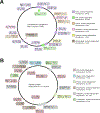The Central Role of Interbacterial Antagonism in Bacterial Life
- PMID: 33022265
- PMCID: PMC7595158
- DOI: 10.1016/j.cub.2020.06.103
The Central Role of Interbacterial Antagonism in Bacterial Life
Abstract
The study of bacteria interacting with their environment has historically centered on strategies for obtaining nutrients and resisting abiotic stresses. We argue this focus has deemphasized a third facet of bacterial life that is equally central to their existence: namely, the threat to survival posed by antagonizing bacteria. The diversity and ubiquity of interbacterial antagonism pathways is becoming increasingly apparent, and the insidious manner by which interbacterial toxins disarm their targets emphasizes the highly evolved nature of these processes. Studies examining the role of antagonism in natural communities reveal it can serve many functions, from facilitating colonization of naïve habitats to maintaining bacterial community stability. The pervasiveness of antagonistic pathways is necessarily matched by an equally extensive array of defense strategies. These overlap with well characterized, central stress response pathways, highlighting the contribution of bacterial interactions to shaping cell physiology. In this review, we build the case for the ubiquity and importance of interbacterial antagonism.
Copyright © 2020 Elsevier Inc. All rights reserved.
Figures


Similar articles
-
Contact-Dependent Interbacterial Antagonism Mediated by Protein Secretion Machines.Trends Microbiol. 2020 May;28(5):387-400. doi: 10.1016/j.tim.2020.01.003. Epub 2020 Feb 12. Trends Microbiol. 2020. PMID: 32298616 Review.
-
Surface-mediated bacteriophage defense incurs fitness tradeoffs for interbacterial antagonism.EMBO J. 2025 May;44(9):2473-2500. doi: 10.1038/s44318-025-00406-3. Epub 2025 Mar 10. EMBO J. 2025. PMID: 40065098 Free PMC article.
-
Contact-dependent interbacterial toxins deliver a message.Curr Opin Microbiol. 2018 Apr;42:40-46. doi: 10.1016/j.mib.2017.09.011. Epub 2017 Nov 1. Curr Opin Microbiol. 2018. PMID: 29078204 Free PMC article. Review.
-
Environmental stimuli drive a transition from cooperation to competition in synthetic phototrophic communities.Nat Microbiol. 2019 Dec;4(12):2184-2191. doi: 10.1038/s41564-019-0567-6. Epub 2019 Oct 7. Nat Microbiol. 2019. PMID: 31591554
-
The type II secretion system as an underappreciated and understudied mediator of interbacterial antagonism.Infect Immun. 2024 Aug 13;92(8):e0020724. doi: 10.1128/iai.00207-24. Epub 2024 Jul 9. Infect Immun. 2024. PMID: 38980047 Free PMC article. Review.
Cited by
-
Potential probiotic approaches to control Legionella in engineered aquatic ecosystems.FEMS Microbiol Ecol. 2022 Jul 28;98(8):fiac071. doi: 10.1093/femsec/fiac071. FEMS Microbiol Ecol. 2022. PMID: 35679082 Free PMC article. Review.
-
The dominant lineage of an emerging pathogen harbours contact-dependent inhibition systems.Microb Genom. 2025 Jan;11(1):001332. doi: 10.1099/mgen.0.001332. Microb Genom. 2025. PMID: 39853206 Free PMC article.
-
Genome Sequencing and Characterization of Bacillus velezensis N23 as Biocontrol Agent against Plant Pathogens.Microorganisms. 2024 Jan 30;12(2):294. doi: 10.3390/microorganisms12020294. Microorganisms. 2024. PMID: 38399699 Free PMC article.
-
Salmonella antibacterial Rhs polymorphic toxin inhibits translation through ADP-ribosylation of EF-Tu P-loop.Nucleic Acids Res. 2022 Dec 9;50(22):13114-13127. doi: 10.1093/nar/gkac1162. Nucleic Acids Res. 2022. PMID: 36484105 Free PMC article.
-
Streptomyces umbrella toxin particles block hyphal growth of competing species.Nature. 2024 May;629(8010):165-173. doi: 10.1038/s41586-024-07298-z. Epub 2024 Apr 17. Nature. 2024. PMID: 38632398 Free PMC article.
References
-
- Brussow H, and Hendrix RW (2002). Phage genomics: small is beautiful. Cell 108, 13–16. - PubMed
-
- Cohen D, Melamed S, Millman A, Shulman G, Oppenheimer-Shaanan Y, Kacen A, Doron S, Amitai G, and Sorek R (2019). Cyclic GMP-AMP signalling protects bacteria against viral infection. Nature 574, 691–695. - PubMed
-
- Depardieu F, Didier JP, Bernheim A, Sherlock A, Molina H, Duclos B, and Bikard D (2016). A Eukaryotic-like Serine/Threonine Kinase Protects Staphylococci against Phages. Cell Host Microbe 20, 471–481. - PubMed
Publication types
MeSH terms
Grants and funding
LinkOut - more resources
Full Text Sources

